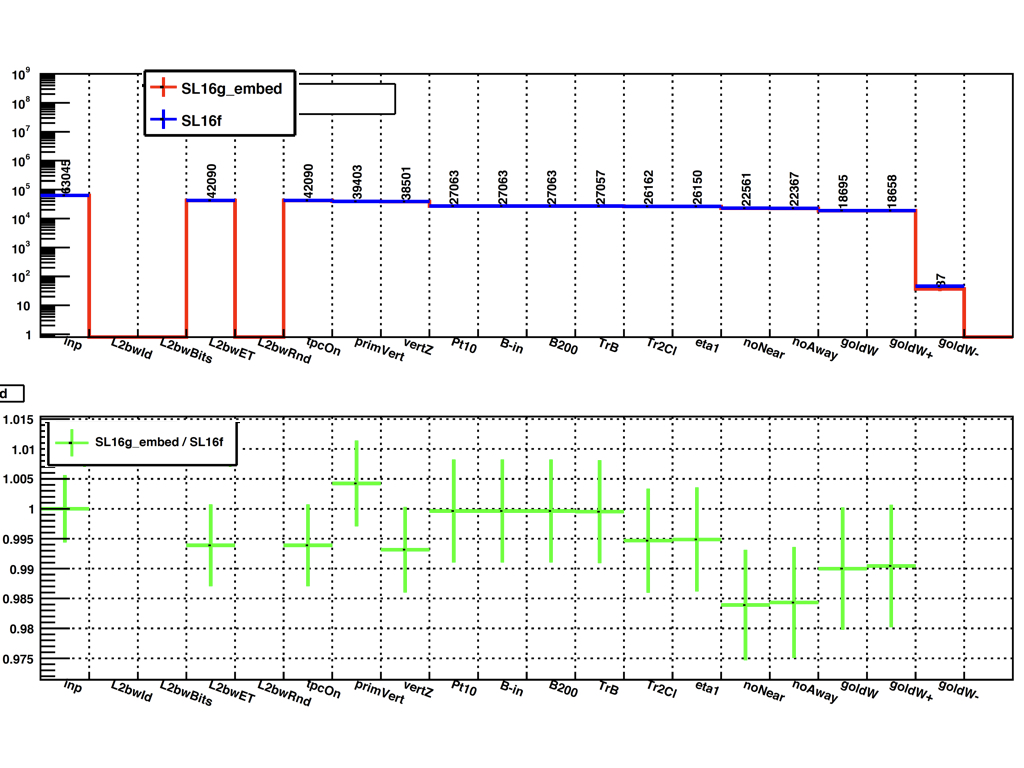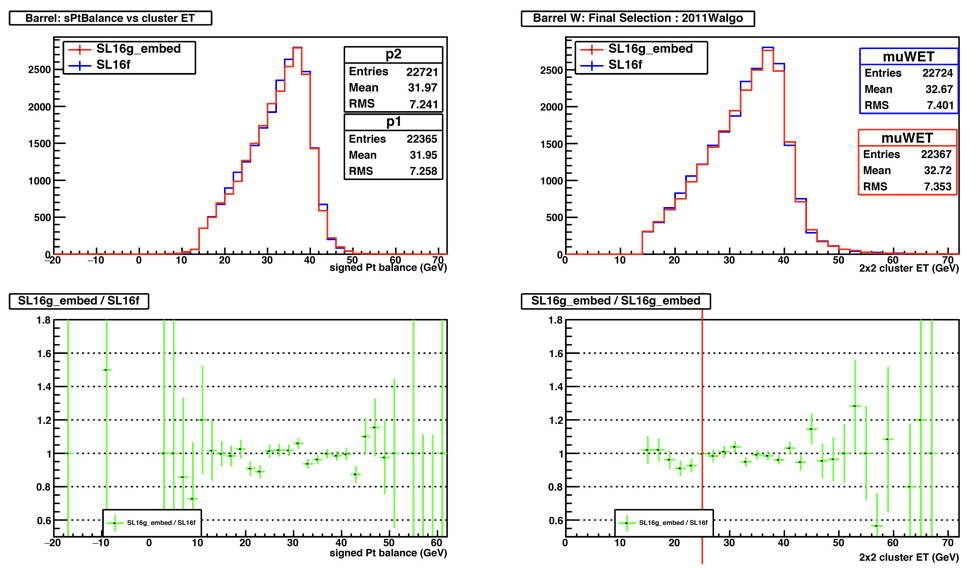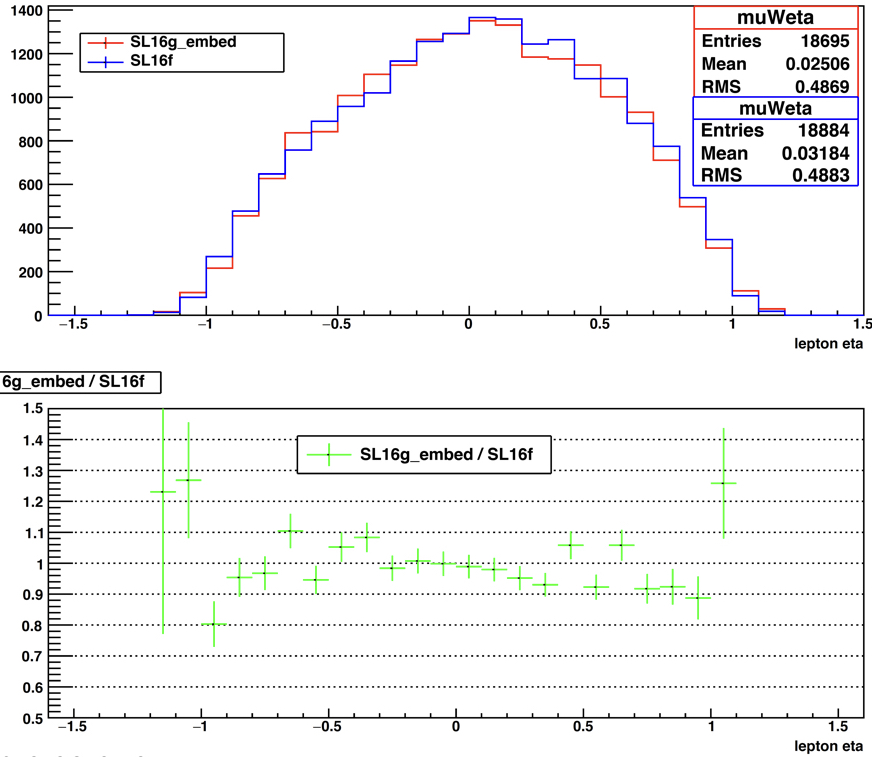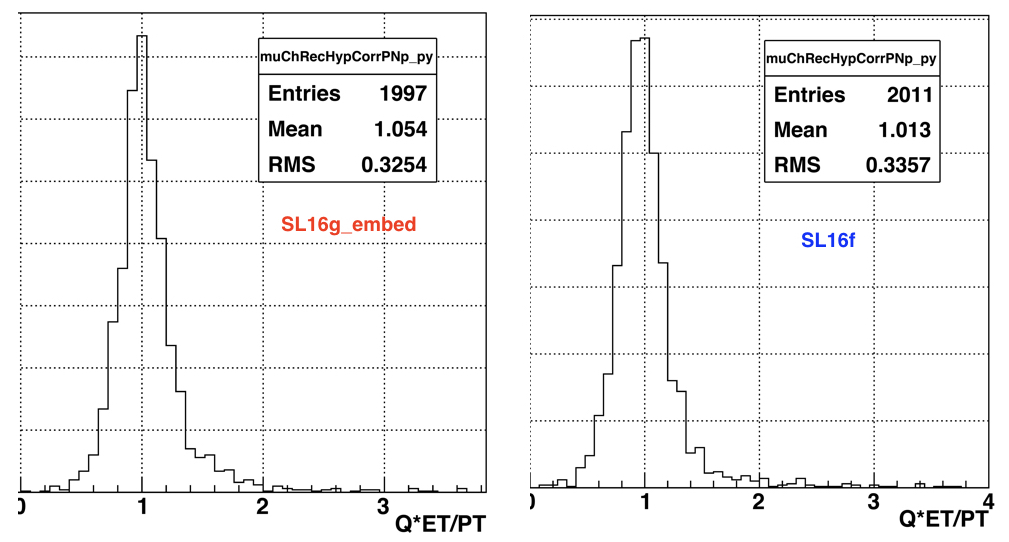Run 13 W Analysis : Final Results : Embedding QA
Embedding QA - SL16g_embed
7/05/17 - updates
Check on Geant level distributions / Particle ID (pid_ID)
***The GEANT level information are not filled in the W trees. Why ?
Looking at the code =>
How we get geant info form MuDsts..
StMcEvent* mMcEvent = 0;
mMcEvent = (StMcEvent*) StMaker::GetChain()->GetDataSet("StMcEvent");
StMcVertex *V=mMcEvent->primaryVertex();
mVertex=TVector3(V->position().x(),V->position().y(),V->position().z());
StMcTrack* mcTrack = mMcEvent->tracks()[i];
int pdgId=mcTrack->pdgId();
if(pdgId==11 || pdgId==-11){ //select e+ and e-
if(mcTrack->parent() && abs(mcTrack->parent()->pdgId()) == 24 ){
pElectron=mcTrack->momentum();
pW=mcTrack->parent()->momentum();
eW=mcTrack->parent()->energy();
Once
[We don't have StMcEvent in our MuDsts, what we have is StMuMcEvent. StMuMcEvent is same as StMcEvent. However, StMuMcEvent does not have all the details that are in StMcEvent. So from where we get "pig_id"s. From geant.root ? ]
7/05/17 - updates
MC W analysis Comparison between the SL16g_embed vs SL16f (Larger sample - 296 runs)
1) Cuts vs Statistics
No enhancement of (~2%) as expected in track reconstruction. In fact a decrees in ~1% can be seen both in primary track reconstruction and in final Ws.

2) Final W ET / Sign PT distributions

3) Final W Eta Distribution

6/28/17
Jinlong's QA page: https://drupal.star.bnl.gov/ST
First, the code was checked to make sure the various parameters (such as PYTHIA parameters, geometry tags, BFC chain options, timestamps, library) are correct. Then the parameters were checked between two codes used for the new production and preliminary productions. Log files were checks to see where proper tracking parameters / status/ calibration tables were grabbed during the productions.
Codes / Logs Checking
| Parameter | SL16g_embed | SL16f | same /diff |
| PYTHIA version*** | 6.4.28 | 6.4.22 | diff |
| PYTHIA (part) library | y2013_1c | y2013_1c | same |
| PYTHIA tune | Perugia 0 | Perugia 0** | ** |
| embedding (part) library (geometry ) | ry2013_1c | ry2013_1c | same |
| Vz_sigma | 47 cm | 42 cm | Diff |
| Track cuts | PPV_W | PPV_W | same |
| Timestamp | checked | checked | correct |
| BFC chain option | checked (STICA) | checked (STICA) | same |
| BEMC gains | Run 9 | Run 9 | same* |
| Beamline constraint | used | used | same |
=>*** PYTHIA version is different (possible changes in the TUNE (pdfs), potentially could impact the event generation process / decay behavior) ===> Need Investigation!!!!!!!
=> ** Possible changes in the tune due to the updates in the version.
=>* As long as same gains are used for the MC-embedding muDst production and for the muDst reading no impact of calibration gains would occurs.
MC W analysis Comparison between the SL16g_embed vs SL16f (small sample - 33 runs)
33 MC runs that were produced and analyzed using W codes were used. New set =>SL16g_embed, Preliminary results production => SL16f=>SL16g library STICA is expected to have more reconstructed tracks (~2%) than SL16f.
=>Comparison plots seems all good. For a such small sample the difference in the shape of the ET distribution of final W looks quite large though. New one looks bit weird. I confirmed both samples were analyzed using the same corresponding gains that were used for the MC muDst production.
=>Did Jinlong Use the same W cuts as preliminary version ????????????
Apple to Apple Comparison Plots
1) Cuts vs Statistics
As expected roughly 1-2% enhancement in tracks can be seen. [not much of a increase in golden W, but this is a very small sample)
Enhancement in track Pt cut expect to continues within other cuts. However the drop in Tr2Cl (Track cluster matching) / or in eta1, and noAway (signPt) is not expected. [We have seen a drop before noNear ( nearCone) cut due to the reduction of more Background) This is problematic. Need investigation !!!

2) Final W ET / Sign PT distributions
The ET distribution (shape) of the new sample is quite different from the old one. For a small sample I would hardly expect a significant difference between them. And the enhancement at low ET is quite worrisome. => Causes form changes in the PYTHIA version ????
.jpeg)
3) Final W Eta Distribution
Looks OK!
.jpeg)
4) Charge-sign Distribution :

Difference Between PYTHIA versions (6.4.22 vs 6.4.28)
PERUGIA Tunes:* The starting point for all the Perugia tunes, apart from Perugia NOCR, was S0A-Pro, i.e., the original tune “S0”, with the Tune A energy scaling (S0A), revamped to include the Professor tuning of flavour and fragmentation parameters to LEP data (S0A-Pro).
PERUGIA 0 (320) [this is what we use.]
* Uses CTEQ5L parton distributions.
* Uses (Lambda) CMW instead of MS(bar) scheme, which results in near-perfect agreement with the Drell-Yan p⊥ spectrum, both in the tail and in the peak.
* Has slightly less colour reconnections than S0(A), especially among high-p⊥ string pieces, which improves the agreement both with the hp⊥i distribution and with the high-p⊥ tail of charged particle p⊥ spectra.
* Slightly more beamremnant breakup than S0(A) (more baryon number transport), mostly in order to explore this possibility than due to any necessity of tuning at this point. Without further changes, these modifications would lead to a greatly increased average multiplicity as well as larger multiplicity fluctuations. To keep the total multiplicity unchanged, relative to S0A-Pro, the changes above were accompanied by an increase in the MPI infrared cutoff, p⊥0, which decreases the overall MPI-associated activity, and by a slightly smoother proton mass profile, which decreases the fluctuations.
* The energy scaling is closer to that of Tune A (and S0A) than to the old default scaling that was used for S0.
Descriptions of 6.4.22 vs 6.4.28 in the updates
6.4.22:
6.4.22 : 11 November 2009
- Bug fixes in PYPTIS for massive quark evolution close to threshold
in annihilation-type processes, for the special case where both
incoming massive quarks get so close to threshold that creation
has to be forced. Previously, the algorithm would then always pick
the Q on side 1 to start with, thus possibly creating an artificial
asymmetry. This choice has now been randomized to alternate
between sides 1 and 2. Also, when performing the creation for the
first Q, the algorithm did not check explicitly whether enough
phase space was still left for creation of the second Q. This is
now ensured as well. Thanks to H. Hoeth and S. Kama for pointing
to issues that led to the identification of this bug.
- Change in PYINPR for MSEL = 39, SUSY production. The manual states
that MSEL = 39 switches on all SUSY production processes except Higgs
production. However, previously MSEL = 39 would switch on the SUSY Higgs
pair production processes 297-301. The meaning of MSEL = 39 has now been
changed to correspond better to what is written in the manual, i.e.,
pair production of states with R-parity = -1, leaving out processes
297-301. Thanks to M. Johansen for pointing this out.
- Protected PYPTFS from compiler-dependent behavior regarding the
logical evaluation of an IF statement. Noticed by S. Kama.
- Enforced initialization of NJN in PYPTIS and of NCHN in
PYPTMI. Added SAVE statement for NCHN in PYPTMI. Should prevent
problems experienced with some compilers, notably
gfortran. Noticed by S. Kama and E. Ozcan.
- Bug fix in PYEVNW to address problems with how particles point
back to their ancestors in the pT-ordered shower when
MSTP(125)<=1. In the new shower, each time a parton acts as a
"recoiler", it is saved as a new copy with modified
momentum. Previously, when using the options MSTP(125)<=1, Pythia
would attempt to compress this history down to a single parton,
but this gave rise to some inconsistent mother-daughter pointers
which in turn resulted in some problems in interpreting the event
history reported by users of the new framework. The "fix" is to
give up on saving space and instead retain each of the recoiler
copies separately, without compressing them down to a single
parton. For MSTP(125)=2 there should be no changes, since this
option is equivalent to keeping the entire branching history
without compression.
- Updated PYLOGO, Skands now at CERN.
6.4.28:
6.4.28 : 05 Sep 2013
- Bug fix in the handling of final-state radiation in decays into a
gluon, specifically q* -> q g, where an incorrect handling of the
matrix element matching leads to a strong suppression of radiation
from the gluon.
- Bug fix in PYUPEV to handle certain processes, such as VV->VV
scattering (MSUB=71-77), where a mother index would become negative.
- Included four new Perugia 2012 variations, one of which is
motivated by theory uncertainties on min-bias, two others having
been requested by the LHC experiments, and the last exploring a
different set of fragmentation parameters, obtained by the
Innsbruck group. Also included 9 new complete ee+pp tunes provided
by G. Rudolph and N. Firdous (Innsbruck), 3 of which use LO PDFs,
3 using NLO ones, and 3 LO* ones. Note that we do not recommend
using NLO or LO* PDFs for serious soft-physics studies, but include
them nonetheless to illustrate the results that one obtains with them.
MSTP(5) =
380 P12-MB2 : same as Perugia 2012, with PARP(87)=0D0 (2013)
381 P12-ueHi : Variation with higher UE (lower pT0) (2013)
382 P12-ueLo : Variation with lower UE (higher pT0) (2013)
383 P12-IBK : Perugia 2012 with IBK ee fragmentation parameters
390 IBK-CTEQ5L : Innsbruck ee+pp tune with CTEQ5 LO PDFs (2013)
391 IBK-CTEQ6LL : with CTEQ6LL LO PDFs
392 IBK-MSTW08LO: with MSTW08 LO PDFS
393 IBK-CTEQ66NLO: with CTEQ66 NLO PDFs
394 IBK-CT10NLO : with CT10 NLO PDFs
395 IBK-MSTW08NLO: with MSTW08 NLO PDFs
396 IBK-MSTW08LO*: with MSTW07 LO* PDFs
397 IBK-MRSTLO**: with MRSTMCal (LO**) PDFs
398 IBK-CT09MC2 : with CTEQ09MC2 PDFs
The variation with PARP(87)=0 (see manual) has a slightly improved
behaviour at very low minimum-bias multiplicities. The new P12 UE
variations are complementary to the existing mpiHi variation (373).
Where the latter increases the amount of semi-hard MPI scatterings
(i.e., the amount of MPI minijets) by increasing the alphaS associated
with MPI, the new variations adjust the soft pT0 scale and hence affect
the amount of soft MPI produced, without changing the rate of hard MPI.
The energy-scaling of the new variations has also been chosen
conservatively, so that the activity of the "ueLo" variation scales
slower with CM energy (i.e., pT0 scales up faster) than for "ueHi".
- Extended PYSLHA to be able to handle more than 25 new particles
introduced via QNUMBERS blocks in SLHA files and/or LHEF
headers. By recycling previously unused space in the particle
arrays, the maximum number of QNUMBERS blocks that can be stored
is now at 130 new particles, at which point the code will advise
you to move to PYTHIA 8 instead. Thanks to A. Belyaev for
pointing to this problem and for help testing the updated PYSHLA.
- Modification of PYPTFS for the case of interleaved showers, where
final state showers occur after initial state showers. In
the previous version, a soft parton from ISR could form a dipole
with a final state parton, leading to a suppression of hard final-
state radiation. In the corrected version, a final-final dipole is
selected, using other hard partons in the final state, unless
the pT-scale is at or below the scale of the original initial-final
dipole. Thanks to Gavin Salam for noticing a problem in jet
masses for certain kinematic configurations. See also the study
reported in section 8.4 of Dasgupta et al., arXiv:1307.0007.
Note that this correction slightly increases the average amount of
FSR in all tunes of the pT-ordered shower. Thus, for instance, the
average multiplicity of minimum-bias events at LHC (7 TeV) increases
by 1 - 2 per cent in this version relative to previous PYTHIA 6 versions.
- Identified a bug in final states including exactly one vector boson
and one quark. This could be a native Pythia process or an
external LHE event. In this case, a matrix element correction is
applied to FSR assuming the decay q -> q V. The effect appears
to be minimal, and no solution is implemented at this time.
Documentations
PYTHIA Tune : PERUGIA Tunes (Click here)
PYTHIA 6.4 updates (Click here)
PARP: (Click here)
- devika's blog
- Login or register to post comments
